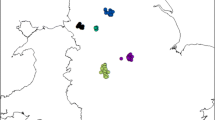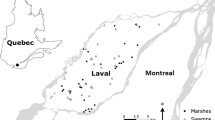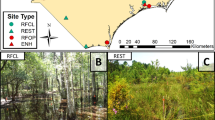Abstract
Urbanization has significantly increased globally during the last century and has far-reaching consequences for biodiversity and their associated habitats, particularly wetland ecosystems. Previous studies have focused primarily on wetlands in non-urban areas, and urban wetland biodiversity patterns are currently not well understood, particularly across Africa. Here, we investigate two highly transformed urban wetlands in Cape Town, South Africa, and determine the relative importance and influence of local environmental variables as drivers of macroinvertebrate richness and community structuring. We also determine the influence of local environmental variables for patterns of species turnover and nestedness within and among these wetlands, and provide management recommendations based on our findings. We found that few macroinvertebrate species were associated with these wetlands, yet community variation was driven by a combination of local environmental variables. Our results also indicate that the turnover component of beta diversity, rather than nestedness, was responsible for most of the variation in the overall macroinvertebrate community. We identified two major problems regarding the current ecological state of the investigated wetlands. Firstly, high nutrient loads originating from the surrounding land uses which reduced wetland biodiversity, and secondly, the transformation of these wetlands from seasonal to perennial water bodies. We recommend local and regional scale approaches to limit urban waste from entering these systems, and management of water levels simulating natural Mediterranean-type climate dynamics more closely are required to ensure that the maximum possible diversity can be supported in these wetlands.



Similar content being viewed by others
Data availability
All data relevant to this study are available at https://doi.org/10.6084/m9.figshare.12609032.
References
Barber-James HM, Lugo-Ortiz CR (2003) Ephemeroptera. In: de Moor I, Day J, de Moor F (eds) Guides to the freshwater invertebrates of southern Africa: Insecta I Ephemeroptera, Odonata and Plecoptera. Water Research Commission, Pretoria, pp 16–142
Barton K (2019) MuMIn: Multi-model inference. R package version 1(42):1 Retrieved from https://CRAN.R-project.org/package=MuMIn
Baselga A (2010) Partitioning the turnover and nestedness components of beta diversity. Glob Ecol Biogeogr 19:134–143
Baselga A, Orme D, Villeger S, De Bortoli J, Leprieur F (2017) Betapart: partitioning beta diversity into turnover and nestedness components. R package version 1:3 Retrieved from https://CRAN.R-project.org/package=betapart
Bates D, Maechler M, Bolker B, Walker S. (2014). lme4: Linear mixed-effects models using S4 classes. R package version 1.1–7. Retrieved from https://CRAN.R-project. org/package=lme4
Batzer DP (2013) The seemingly intractable ecological responses of invertebrates in north American wetlands: a review. Wetlands 33:1–15
Batzer DP, Cooper R, Wissinger SA (2006) Wetland animal ecology. In: Batzer DP, Sharitz RR (eds) Ecology of freshwater and estuarine wetlands. University of California Press, Berkeley, pp 242–284
Biggs J, Fox G, Nicolet P, Walker D, Whitfield M, Williams P (1998) A guide to the methods of the national pond survey. Pond Action, Oxford
Biggs J, Williams P, Whitfield M, Nicolet P, Weatherby A (2005) 15 years of pond assessment in Britain: results and lessons learned from the work of pond conservation. Aquat Conserv Mar Freshwat Ecosyst 15:693–714
Bird MS, Day JA (2016) Impacts of terrestrial habitat transformation on temporary wetland invertebrates in a sclerophyllous sand fynbos landscape. Hydrobiologia 782:169–185
Briggs AJ, Pryke JS, Samways MJ, Conlong DE (2019) Macrophytes promote aquatic insect conservation in artificial ponds. Aquat Conserv Mar Freshwat Ecosyst 29:1190–1201
Camargo JA, Alonso A (2006) Ecological and toxicological effects of inorganic nitrogen pollution in aquatic ecosystems: a global assessment. Environ Int 32:831–849
Camargo JA, Alonso A, Salamanca A (2005) Nitrate toxicity to aquatic animals: a review with new data for freshwater invertebrates. Chemosphere 58:1255–1267
Carrino-Kyker SR, Swanson AK (2007) Seasonal physicochemical characteristics of thirty northern Ohio temporary pools along gradients of GIS-delineated human land-use. Wetlands 27:749–760
Courtney GW, Cranston PS (2015) Chapter 40: Order Diptera. In: Thorp JH, Rogers DC (eds) Thorp and Covich's freshwater invertebrates: ecology and general biology. Elsevier, Amsterdam, pp 2155–2182
Cowan GI (1995) Wetland regions of South Africa. Department of Environmental Affairs and Tourism, Pretoria
Czajkowski J, Villarini G, Montgomery M, Michel-Kerjan E, Goska R (2017) Assessing current and future freshwater flood risk from North Atlantic tropical cyclones via insurance claims. Nature 7:41609
Davidson N (2014) How much wetland has the world lost? Long-term and recent trends in global wetland area. Mar Freshw Res 65:934–942
Davies BR, Day JA (1998) Vanishing waters. University of Cape Town Press, Cape Town
Day JA (1987) Conservation and management of wetlands in the greater Cape Town area. In: Walmesley RD, Botten ML, compilers. Proceedings of a symposium on ecology and conservation of wetlands in South Africa. Occasional report series no 28. Ecosystem Programmes. Foundation for Research Development, CSIR, Pretoria
Deacon C, Samways MJ, Pryke JS (2019) Aquatic insects decline in abundance and occupy low-quality artificial habitats to survive hydrological droughts. Freshw Biol 64:1643–1654
Development Core Team R (2016) R: a language and environment for statistical computing. R Foundation for Statistical Computing, Vienna Retrieved from http://www.R-project.org/
Elumalai V, Brindha K, Sithole B, Lakshmanan E (2017) Spatial interpolation methods and geostatistics for mapping groundwater contamination in a coastal area. Environ Sci Pollut Res 24:11601–11617
Erwin KL (2009) Wetlands and global climate change: the role of wetland restoration in a changing world. Wetl Ecol Manag 17:71–84
Fairchild GW, Cruz J, Faulds M, Short AEZ, Matta JF (2003) Microhabitat and landscape influences on aquatic beetle assemblages in a cluster of temporary and permanent ponds. J N Am Benthol Soc 22:224–240
Griffiths C, Day J, Picker M (2015) Freshwater life. A field guide to the plants and animals of southern Africa, Struik Nature, Cape Town
Harding WR, Wright S (1999) Initial findings regarding changes in phyto- and zooplankton composition and abundance following the temporary drawdown and refilling of a shallow, hypertrophic south African coastal lake. J Lake Reservoir Manage 15:47–53
Harrison AD (2003) Chironomidae. In: Day J, Harrison AD, de Moor IJ (eds) Guides to the freshwater invertebrates of southern Africa: Diptera. Water Research Commission, Pretoria, pp 110–158
Hassall C (2014) The ecology and biodiversity of urban ponds. Wiley Interdiscip Rev Water 1:187–206
Hassall C, Anderson S (2015) Stormwater ponds can contain comparable biodiversity to unmanaged wetlands in urban areas. Hydrobiologia 745:137–149
Heino J, Bini LM, Andersson J, Bergsten J, Bjelke U, Johansson F (2017) Unravelling the correlates of species richness and ecological uniqueness in a metacommunity of urban pond insects. Ecol Indic 73:422–431
Hill MJ, Heino J, Thornhill I, Ryves DB, Wood PJ (2017a) Effects of dispersal mode on the environmental and spatial correlates of nestedness and species turnover in pond communities. Oikos 126:1575–1585
Hill MJ, Biggs J, Thornhill I, Briers RA, Gledhill DG, White JC, Wood PJ, Hassall C (2017b) Urban ponds as an aquatic biodiversity resource in modified landscapes. Glob Chang Biol 23:986–999
James KR, Cant B, Ryan T (2003) Responses of freshwater biota to rising salinity levels and implications for saline water management: a review. Aust J Bot 51:703–713
Knop E (2016) Biotic homogenization of three insect groups due to urbanization. Glob Chang Biol 22:228–236
Legendre P (2014) Interpreting the replacement and richness difference components of beta diversity. Glob Ecol Biogeogr 23:1324–1334
Legendre P, Birks HJB (2012) From classical to canonical conservation. In: Birks HJB et al (eds) Tracking environmental change using lake sediments. Springer, Dordrecht, pp 201–248
Li X, Chen G, Liu X, Liang X, Wang S, Chen Y, Pei F, Xu X (2017) A new global land-use and land-cover change product at a 1-km resolution for 2010 to 2100 based on human–environment interactions. Ann Am Assoc Geogr 107:1040–1059
Lytle DA (2015) Chapter 37: Order Hemiptera. In: Thorp JH, Rogers DC (eds) Thorp and Covich's freshwater invertebrates: ecology and general biology. Elsevier, Amsterdam, pp 1953–1979
Matthews GVT (1993) The Ramsar convention on wetlands: its history and development. Ramsar Convention Bureau, Gland
McKinney ML (2008) Effects of urbanization on species richness: a review of plants and animals. Urban Ecosyst 11:161–176
Mlambo MC, Bird MS, Reed CC, Day JA (2011) Diversity patterns of temporary wetland macroinvertebrate assemblages in the south-western cape, South Africa. Afr J Aquat Sci 36:299–308
Mnaya B, Mwangomo E, Wolanski E (2006) The influence of wetlands, decaying organic matter, and stirring by wildlife on the dissolved oxygen concentration in eutrophicated water holes in the Seronera River, Serengeti National Park, Tanzania. Wetl Ecol Manag 14:421–425
Moges A, Beyene A, Ambelu A, Mereta ST, Triest L, Kelbessa E (2017) Plant species composition and diversity in wetlands under forest, agriculture and urban land uses. Aquat Bot 138:9–15
Oksanen J, et al. (2017). Vegan: community ecology package. R package version 2.4–2. Retrieved from https://CRAN.R-project.org/package=vegan
Paradis E, Schliep K (2018) Ape 5.0: an environment for modern phylogenetics and evolutionary analyses in R. Bioinformatics 35:526–528
Parker KA, Springall BT, Garshong RA, Malachi AN, Dorn LE, Costa-Terryll A et al (2019) Rapid increases in bat activity and diversity after wetland construction in an urban ecosystem. Wetlands 39:717–727
Quantum GIS Development Team. (2017). Quantum GIS geographic information system. Open source Geospatial Foundation project. Retrieved from http://qgis.osgeo.org
Reavell P (2003) Hemiptera. In: de Moor I, Day J, de Moor F (eds) Guides to the freshwater invertebrates of southern Africa: Insecta II Hemiptera, Megaloptera, Neuroptera, Trichoptera and Lepidoptera. Water Research Commission, Pretoria, pp 16–71
Reid AJ, Carlson AK, Creed IF, Eliason EJ, Gell PA, Johnson PTJ, Kidd KA, MacCormack TJ, Olden JD, Ormerod SJ, Smol JP, Taylor WW, Tockner K, Vermaire JC, Dudgeon D, Cooke SJ (2019) Emerging threats and persistent conservation challenges for freshwater biodiversity. Biol Rev 94:849–873
Revelle W (2019) psych: procedures for personality and psychological research. R package version 1.9.12. Retrieved from https://CRAN.R-project.org/package=psych
Samways MJ, Simaika JP (2016) Manual of freshwater assessment for South Africa: dragonfly biotic index. In: Suricata 2. South African National Biodiversity Institute, Pretoria
Seaman MT, Kok DJ, Watson M (1999) Cladocera. In: Day JA, Stewart BA, de Moor IJ, Louw AE. Guides to the Freshwater invertebrates of southern Africa: Crustacea I. Water Research Commission, Pretoria, pp 81–110
Soucek DJ, Dickinson A (2012) Acute toxicity of nitrate and nitrite to sensitive freshwater insects, mollusks, and a crustacean. Arch Environ Contam Toxicol 62:233–242
Stals R (2003) Coleoptera. In: Stals R, de Moor IJ (eds) Guides to the freshwater invertebrates of southern Africa: Coleoptera. Water Research Commission, Pretoria
Suhling F, Müller O, Martens A (2014) Namibian dragonflies: larval key and distribution. Libellula Suppl 13:5–106
Suhling F, Sahlén G, Gorb S, Kalkman VJ, Dijkstra KDB, van Tol J (2015) Chapter 37: Order Odonata. In: Thorp JH, Rogers DC (eds) Thorp and Covich's freshwater invertebrates: ecology and general biology. Elsevier, Amsterdam, pp 1837–1914
Tessier C, Cattaneo A, Pinel-Alloul B, Galanti G, Morabito G (2004) Biomass, composition and size structure of invertebrate communities associated to different types of aquatic vegetation during summer in Lago di Candia (Italy). J Limnol 63:190–198
Thomaz SM, Ribeiro de Cunha E (2010) The role of macrophytes in habitat structuring in aquatic ecosystems: methods of measurement, causes and consequences on animal assemblages’ composition and biodiversity. Acta Limnologica Brasiliensia 22:218–236
Thornhill IA, Biggs J, Hill MJ, Briers R, Gledhill D, Wood PJ, Gee JH, Ledger M, Hassall C (2018) The functional response and resilience in small waterbodies along land-use and environmental gradients. Glob Chang Biol 24:3079–3092
Vavrek MJ. (2011) fossil: palaeoecological and palaeogeographical analysis tools. R package version 0.4.0. Retrieved from https://CRAN.R-project. org/package=fossil
Viana DS, Figuerola J, Schwenk K, Manca M, Hobaek A, Mjelde M, Preston CD, Gornall RJ, Croft JM, King RA, Green AJ, Santamaría L (2016) Assembly mechanisms determining high species turnover in aquatic communities over regional and continental scales. Ecography 39:281–288
Williams DD (2006) The biology of temporary waters. Oxford University Press, Oxford
Woodward RT, Wui Y (2001) The economic value of wetlands: a meta-analysis. Ecol Econ 37:257–270
Yee DA, Kehl S (2015) Chapter 39: order Coleoptera. In: Thorp JH, Rogers DC (eds) Thorp and Covich's freshwater invertebrates: ecology and general biology. Elsevier, Amsterdam, pp 2056–2154
Yuan S, Li H, Dang Y, Liu C (2017) Effects of triphenyl phosphate on growth, reproduction and transcription of genes of Daphnia magna. Aquat Toxicol 195:58–66
Zacharias I, Zamparas M (2010) Mediterranean temporary ponds: a disappearing ecosystem. Biodivers Conserv 19:3827–3834
Zedler JB, Kercher S (2005) Wetland resources: status, trends, ecosystem services, and restorability. Annu Rev Environ Resour 30:39–74
Acknowledgements
We express our gratitude to Asieff Khan for accommodating our field work, and The University of Huddersfield who funded the study. We also thank BemLab in Strand, South Africa for analyzing our water chemistry samples. This work was permitted under CapeNature permit number CN44-31-9870 and CN35-31-9871.
Funding
This study was funded by the University of Huddersfield.
Author information
Authors and Affiliations
Contributions
Charl Deacon: Conceptualization, Methodology, Formal analysis, Investigation, Data curation, Writing – Original draft, Visualization, Resources, Project administration.
Bethany R. S. Fox: Writing – Review and editing, Project administration, Funding acquisition.
Leigh Morland: Writing – Review and editing, Project administration, Funding acquisition.
Michael J. Samways: Resources, Writing – Review and editing.
Shannon Weaver: Writing – Review and editing.
Ruth Massey: Writing – Review and editing, Funding acquisition.
Matthew J. Hill: Conceptualization, Methodology, Formal analysis, Investigation, Data curation, Writing – Review and editing, Project administration, Funding acquisition.
Corresponding author
Ethics declarations
Conflict of interest
The authors declare that they have no conflicts of interest.
Ethics approval
Not applicable.
Consent to participate
Not applicable.
Consent for publication
Not applicable.
Code availability
All data relevant to this study are available at https://doi.org/10.6084/m9.figshare.12609032.
Supplementary Information
Online Resource 1
Shapiro-Wilks normality test and Mantel spatial autocorrelation test results for overall species richness, and species richness for Zeekoevlei and Rondevlei separately. (DOCX 14 kb)
Online Resource 2
Cross-correlation plots and Spearman’s rank order correlation test results among % emergent vegetation cover, % submerged vegetation cover, conductivity (μS cm-1), pH, temperature (°C), dissolved oxygen concentration (mg/L), chlorine concentration (mg/L), phosphate concentration (mg/L), nitrite-nitrogen concentration (mg/L), Escherichia coli levels (cfu/100 ml) and faecal coliform levels (cfu/100 ml). Significance levels: *: p < 0.05; **: p < 0.01; ***: p < 0.001. (DOCX 319 kb)
Online Resource 3
Species list of all macroinvertebrates sampled. 1: present; 0: absent. (DOCX 17 kb)
Rights and permissions
About this article
Cite this article
Deacon, C., Fox, B.R.S., Morland, L. et al. Patterns in macroinvertebrate taxonomic richness and community assembly among urban wetlands in Cape Town, South Africa: implications for wetland management. Urban Ecosyst 24, 1061–1072 (2021). https://doi.org/10.1007/s11252-021-01102-w
Accepted:
Published:
Issue Date:
DOI: https://doi.org/10.1007/s11252-021-01102-w




